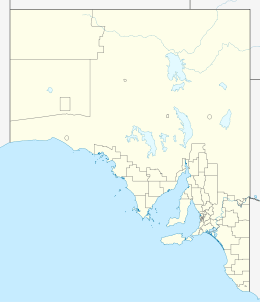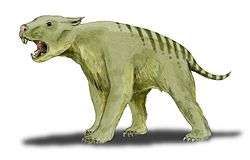Green Waterhole Cave
| Fossil Cave | |
|---|---|
| Green Waterhole Cave, 5L81 | |
 | |
| Location | Princes Highway, near Tantanoola, Australia |
| Coordinates | 37°43′55″S 140°31′49″E / 37.7319°S 140.5302°ECoordinates: 37°43′55″S 140°31′49″E / 37.7319°S 140.5302°E |
| Depth | 15 metres (49 ft) |
| Length | 70 metres (230 ft) |
| Geology | Oligocene coralline limestone |
| Entrances | 1 |
| Difficulty |
Above water - no stated difficulty Underwater - CDAA Cave grade |
| Hazards | silting, overhead environment |
| Access |
Above water - public (no disabled access). Underwater - CDAA members only. |
| Cave survey |
FUUC, 1978 Allum and Garrad, 1979 SAUSS, 1987 Horne, 1986-88 |


Green Waterhole Cave (5L81), also known as Greenwater Hole and Fossil Cave, is a cave in the Limestone Coast region of south-eastern South Australia. It lies about 22 kilometres (14 miles) north-west of the city of Mount Gambier, only a few metres from the Princes Highway (Route B1) between Mount Gambier and Millicent. It is notable both as a paleontological site and as a cave diving site.
Description
The cave is formed in 30-million-year-old Oligocene coralline limestone. The cave is a karst sinkhole and is largely filled with water. The surface depression is about 20 metres (66 ft) long and 10 metres (33 ft) wide. Beneath the surface it extends to a maximum length of 70 metres (230 ft) and a width of 30 metres (98 ft).[1]
Fossils
Since the mid 1960s, a variety of Pleistocene subfossil material of birds and mammals has been found and recovered by divers from the surface of a rockpile to a depth of about 15 metres (49 ft) below the water surface. The probable accumulation mode was by animals drowning when they fell into the cave while attempting to use it as a source of drinking water. Dating of the subfossil remains indicated that their deposition occurred mainly between 15,000 and 40,000 years ago. As well as representing many living animals, examples of extinct species recovered from the cave include the birds Centropus colossus and Orthonyx hypsilophus,[2] and the mammals Thylacinus cynocephalus, Thylacoleo carnifex, Propleopus oscillans, Macropus titan, Protemnodon anak, and the sthenurine kangaroos Procoptodon gilli, Procoptodon maddocki and Simosthenurus occidentalis.[3]
Exploration
Fossils were first collected from the cave in 1964 followed by a further collection in 1968, a number of expeditions which were organised by the South Australian Museum from years 1968 to 1974 and an excavation carried out by the South Australian Underwater Speleological Society (SAUSS) in 1987.[1][4] The cave’s submerged extent has been surveyed at least three times including by the Flinders University Underwater Club (FUUC) in 1978, Allum and Garrad in 1979 and the SAUSS in 1987.[1][5][6][7]
Recreational diving
Green Waterhole Cave is a notable cave diving site which is known in cave diving literature as Fossil Cave. Access for cave diving is limited to holders of the Cave Divers Association of Australia's Cave grade.[8]
See also
References
- 1 2 3 Horne, Peter (1988). ”Fossil Cave” (5L81) Underwater Palaeontological and Surveying Project, 1987–1988 (PDF). Project Report No.1. Elizabeth Downs: South Australian Underwater Speleological Society.
- ↑ Baird, Robert F. J. (1985). "Avian fossils from Quaternary deposits in 'Green Waterhole Cave', south-eastern South Australia" (PDF). Records of the Australian Museum. 37 (6): 353–370. doi:10.3853/j.0067-1975.37.1985.332.
- ↑ Reed, E. H.; Bourne, S. J. (2000). "Pleistocene fossil vertebrate sites of the south-east region of South Australia" (PDF). Transactions of the Royal Society of South Australia. 124 (2): 84.
- ↑ Horne, Peter (2007). "A Brief History of South Australian Cave Diving". Peter Horne. pp. 26–27. Retrieved 1 November 2012.
- ↑ Lewis, I; Stace, P. (1982). Cave Diving in Australia (Revised ed.). Adelaide: Ian Lewis & Peter Stace. pp. 136–137. ISBN 0959496300.
- ↑ Rogers, P; Hiscock, J (September 1981). "Diving for fossils". CDAA Occasional Paper Number 2. Cave Divers Association of Australia: 9–12.
- ↑ Williams, D (September 1981). "Fossils from Fossil Cave". CDAA Occasional Paper Number 2. Cave Divers Association of Australia: 4–8.
- ↑ "Fossil Cave". Cave Divers Association of Australia. Retrieved 30 June 2014.
